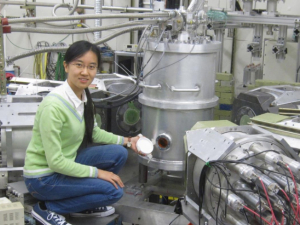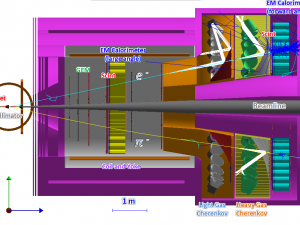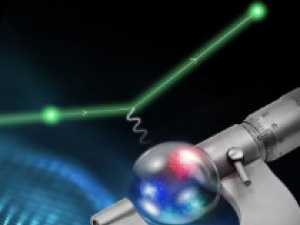Viewing Nucleons and Nuclei Through the Lens of Quantum Chromodynamics (QCD)
Describing hadron structure and the nuclear force in terms of quantum chromodynamics (QCD) is among the grand challenges at the frontier of physics. The main thrust of the QCD program at TUNL is to conduct experiments that provide new insights about nucleon structure over distances and energies relevant to the emergence of the macroscopic properties of nucleons and about interactions of nucleons inside nuclei. The program has three intellectually overlapping areas of investigation that probe nuclear phenomena from low to medium energies:
- the nuclear force inside few-nucleon systems and light nuclei,
- nucleon structure at long distances, and
- quark and gluon generation of nucleon properties.
The research on nucleon-nucleon interactions inside nuclei is conducted at the tandem laboratory and at HIGS. The long-distance structure of nucleons is probed by Compton scattering experiments that use the monoenergetic and polarized y-ray beam at HIGS and by low-momentum electron scattering at JLab. The roles of the quarks and gluons in shaping the structure of nucleons is explored via medium-energy nuclear-physics experiments carried out by TUNL research groups at JLab.
Projects
Investigation of Nucleon Interactions Inside Light Nuclei
Effective field theories (EFT) and Lattice QCD calculations provide theoretical frameworks that connect low-energy nuclear phenomena to QCD. An organizing objective of low-energy QCD research is to develop descriptions of bound-state properties of nuclei, few-nucleon reactions, and the low-energy properties of nucleons in terms of QCD. The driving goal of few-nucleon research at TUNL is to perform high-precision measurements that contribute to advancing ab-initio calculations of nuclear structure and reactions, in particular those with sensitivity to properties of the neutron-neutron interaction that are not accessible in two-nucleon systems and to effects of three-nucleon interactions. The current experiment program at TUNL consists of measurements of photon-induced reactions using the nearly mono-energetic and polarized gamma-ray beam at HIGS and of neutron-induced reactions using the nearly mono-energetic and pulsed neutron beam at the tandem laboratory.
The Project Team: TUNL Faculty: Mohammad Ahmed, Ben Crowe, Calvin Howell, Diane Markoff, Werner Tornow, Albert Young; TUNL Students: Collin Malone (Duke), Ronald Malone (Duke); Post-Docs/Research Scientists: Alexander Crowell, Forrest Friesen; Collaborators: A. Deltuva (Vilnius Univ., Lithuania), H. Witala (Jagillonian Univ., Poland)
Nucleon Structure Measurements via Compton Scattering
Chiral effective field theories (yEFT) provide QCD descriptions of low-energy properties of hadrons in terms of effective degrees of freedom. The electromagnetic (EM) polarizabilities of nucleons are fundamental low-energy structure constants that constrain the parameters in yEFT and evaluate lattice QCD calculations. In the classical model, the polarizabilities measure the “stiffness” response of the nucleon to externally applied electric or magnetic fields. In addition to the scalar EM polarizabilities, there are spin-dependent polarizabilities. The spin-polarizabilities describe the stiffness of the internal degrees of freedom of the nucleon associated with the nucleon spin. The HIGS Compton collaboration is performing high precision Compton-scattering measurements on the proton, deuteron and light nuclei to determine the dynamical dipole electric and magnetic polarizabilities of the proton and neutron in the energy range from 60 to 100 MeV using the high intensity mono-energetic and polarized gamma-ray beam at HIGS. An increase in the energy capability of HIGS up to 120 MeV will create new opportunities for measurements of the spin polarizability parameters using Compton scattering of polarized gamma-rays from active polarized targets.
The Project Team: TUNL Faculty: Mohammad Ahmed, Ben Crowe, Calvin Howell, Haiyan Gao, Hugon Karwowski, Diane Markoff, Ying Wu, Kent Leung; TUNL Students: Xiaqing Li (Duke), D. Godagama (UKy); Post-Docs/Research Scientists: Mark Sikora, S. Mikhailov; Collaborators: J. Feldman, H. Grieshammer, E. Downie (GWU), M. Kovash (UKy), A. Banu, C.S. Whisnant (JMU), R. Pywell (USask), M. Spraker (GCSU); Technical Staff: Z. Zhao, G. Swift, M. Emamian, P. Wallace (DFELL)
The Quark-Gluon Nature of Nucleons
-
The Solenoidal Large Intensity Device (SoLID) and the SoLID Physics Program
To exploit the full discovery potential of the Jefferson Lab (JLab) 12-GeV energy upgrade, a large acceptance, high luminosity device, the Solenoidal Large Intensity Device (SoLID), was proposed for Hall A at JLab to address some of the most important questions concerning the structure of the nucleon. The core physics program with SoLID includes three semi-inclusive deep inelastic scattering (SIDIS) experiments of electrons from polarized NH3 (proton) and polarized 3He (effective polarized ``neutron’’) targets to probe the internal three-dimensional structure of the nucleon, uncovering the rich QCD dynamics and the puzzle of the nucleon spin; one precise measurement of the J/Ψ production cross section near the threshold on the proton to probe the QCD trace anomaly, an important piece to the proton mass puzzle; and one parity-violating electron scattering experiment in deep inelastic scattering region to provide unique tests of the Standard Model with a sensitivity to new physics in an energy region comparable to that at the LHC. The JLab 12-GeV energy is unique in its kinematic reach to the valence quark region, complementing the sea quark/gluon region accessed by a future electron-ion collider (EIC). Further, the core of the SoLID science program overlaps with two of the three science questions of the EIC.
The Project Team: TUNL Faculty: H. Gao; The SoLID collaboration has more than 250 members from over 70 institutions in 13 countries. The Medium Energy Physics Group (PI: Gao) at TUNL and Duke is leading the SoLID SIDIS Physics program.
-
The Proton Charge Radius Measurement at the Jefferson Lab
In 2010 a measurement of the proton charge radius using a muonic hydrogen Lamb shift method was reported that was incredibly precise (<0.1%) yet 7σ smaller than the compilation of other electron-based results. This large discrepancy generated the “proton charge radius puzzle” and triggered tremendous experimental and theoretical efforts attempting to resolve the puzzle. The PRad collaboration at Jefferson Lab developed and performed a new e-p elastic scattering measurement in experimental Hall B. This experiment utilized, for the first time, a magnetic-spectrometer-free approach and extracted the charge radius from an unprecedentedly low four-momentum transfer squared region. The extracted charge radius result, 0.831(14) fm – published in Nature (November 2019) – is in agreement with the muonic hydrogen spectroscopic results and the most recent measurement from hydrogen Lamb shift.
The Project Team: TUNL Faculty: H. Gao; The Medium Energy Physics Group at TUNL and Duke is playing a leading role in this experiment.




